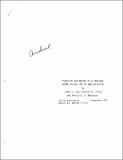Stability and mixing of a vertical round buoyant jet in shallow water
Author(s)
Lee, Joseph Hun-Wei; Jirka, Gerhard Hermann; Harleman, Donald R. F.
DownloadMIT-EL-74-014-02009388.pdf (4.352Mb)
Metadata
Show full item recordAbstract
Discharging heated water through submerged vertical round ports
located at the bottom of a receiving water body is a currently used
method of waste heat disposal. The prediction of the temperature
reduction in the near field of the buoyant jet is a problem of
environmental concern.
The mechanics of a vertical axisymmetric buoyant jet in shallow
water is theoretically and experimentally investigated. Four flow
regimes with distinct hydrodynamic properties are discerned in the
vicinity of the jet: the buoyant jet region, the surface impingement
region, the internal hydraulic jump, and the stratified counterflow
region. An analytical framework is formulated for each region. The
coupling of the solutions of the four regions yields a prediction of
the near field stability as well as the temperature reduction of the
buoyant discharge.
It is found that the near field of the buoyant jet is stable only
for a range of jet densimetric Froude numbers and submergences. A theoretical solution is given for the stability criterion and the dilution of
an unstable buoyant jet.
A series of experiments were conducted to verify the theory. The
experimental results are compared to the theoretical predictions. Good
agreement is obtained.
Description
Also issued as a M.S. thesis in the Department of Civil Engineering at Massachusetts Institute of Technology
Date issued
1974Publisher
MIT Energy Lab
Other identifiers
02009388
Series/Report no.
MIT-EL74-014
Keywords
Jets -- Fluid dynamics, Waste heat, Thermal pollution of rivers, lakes
Collections
The following license files are associated with this item: